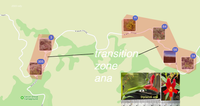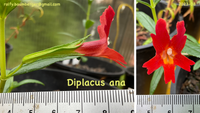Santa Ana Transition - formation on the fly! The birth of a plant variety in almost no time.
Richard Beeks mentioned in his 1961 thesis an occurrence of Diplacus calycinus in a small area along the Ortega Highway peak.
It is found along the Long Canyon Rd for a couple of miles. From 2010, the plants thrived more abundantly, and the flowers also showed variable coloration from 2013. After another twelve years of observation, larger populations of up to 100 plants became established, with flower size and coloration increasingly different from the original shape. It was shown that these new traits were heritable (2017). Shapes with bright orange flowers appear to be slowly developing, with slightly shorter and smaller petals than the citrus yellow flowers of the original calycinus type. Hybridization with Diplacus puniceus is very unlikely here. Therefore it must be a transition that may result in speciation. The individuals are far from stable (data not shown). A clear tendency to this transition is seen in several populations (2022). Flowering time: mid May to mid June.
see: lat long Map Google
Note: Data was sampled from a population of 80 plant individuals exclusively during all these years. The altered floral shape is heritable.
Change in flower color variability over the past 13 years in a Santa Ana population.
Transition stages from Diplacus calycinus (c) to variety "ana" (r) (Santa Ana Mts 2013) Diplacus puniceus var. "ana" or "lamarcki-ana"






